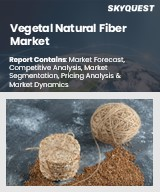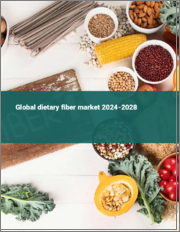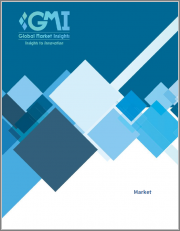
|
시장보고서
상품코드
1618225
감귤류 식이섬유 기회와 성장 촉진요인, 산업 동향 분석 및 전망(2024-2032년)Citrus Based Dietary Fibers Market Opportunity, Growth Drivers, Industry Trend Analysis, and Forecast 2024 to 2032 |
||||||
세계 감귤류 식이섬유 시장은 2023년 16억 달러 규모에 달할 것으로 예상되며, 건강과 영양에 대한 소비자의 관심이 높아짐에 따라 2024-2032년까지 연평균 6.2%의 성장률을 보일 것으로 예측됩니다. 건강한 라이프스타일을 우선시하고 영양가 높은 식품에 더 많은 지출을 하는 소비자가 증가함에 따라 플라보노이드, 카로틴, 폴리페놀과 같은 생리활성 화합물을 함유한 제품에 대한 수요가 크게 증가할 것으로 예상됩니다. 음료 및 식품의 영양 기준을 강화하기 위한 정부의 지원적 규제는 시장 확대를 더욱 촉진하고 있습니다. 수용성 섬유와 불용성 섬유를 결합하는 기술의 발전도 시장 성장을 가속하고 있지만, 감귤류 껍질의 가격 변동과 제한된 원료 공급 지역이 가격 책정에 영향을 미치고 있습니다.
또한, 높은 R&D 비용과 대체품의 존재는 산업 발전에 도전이 될 수 있습니다. 펙틴 부문은 21억 달러 규모이며 2032년까지 6.4%의 연평균 복합 성장률(CAGR)을 나타낼 것으로 예상됩니다. 펙틴의 농축, 안정화 및 겔화 능력은 과일 가공, 특히 요구르트 및 디저트와 같은 제품에 매우 바람직합니다. 제약 부문에서는 펙틴의 수분 보유 능력과 소화가 잘되는 특성을 활용하려는 움직임이 가속화되고 있으며, 항암 효과도 기대되고 있습니다.
잼, 마멀레이드 및 기타 보존 식품에 대한 수요는 소비자의 식습관 변화와 식감 및 겔화 특성을 개선한 식품에 대한 관심 증가에 힘입어 증가하고 있습니다. 감귤류 식이섬유 시장에서 과일 보존 식품 응용 분야는 31%의 점유율을 차지하며 2023년 5억 1,910만 달러에 달할 것으로 예상되며, 2032년까지 6.4%의 연평균 복합 성장률(CAGR)을 나타낼 전망입니다. 감귤류 식이섬유는 기능성 및 건강 지향적 음료에 대한 선호도가 높아짐에 따라 식이섬유 함량을 높이기 위해 과일 보존제 및 음료에 대한 사용이 증가하고 있습니다. 또한 감귤류 식이섬유는 육류, 생선, 풍미 식품의 천연 결합제 및 풍미 강화제로 사용되어 클린 라벨 제품 트렌드를 뒷받침하고 있습니다. 제약업계도 장 건강 증진에 도움이 되는 프리바이오틱스 특성을 지닌 감귤류 식이섬유를 높이 평가했습니다.
| 시장 범위 | |
|---|---|
| 시작 연도 | 2023년 |
| 예측 연도 | 2024-2032년 |
| 시작 가격 | 16억 달러 |
| 예상 가격 | 27억 달러 |
| CAGR | 6.2% |
미국 감귤류 식이섬유 시장은 2032년까지 7억 8,690만 달러에 달할 것으로 예상되며, 연평균 5.9%의 성장률을 보일 것으로 전망됩니다. 식품 품질 향상을 촉진하는 정부 기준과 첨가물로서 카라기난의 특혜가 시장 성장을 가속하고 있습니다. 카라기난의 용도는 통조림 고기, 생선, 소금에 절인 식품, 베이커리 제품까지 확대되어 영양가와 식감을 향상시켜 산업 내 수요를 더욱 촉진하고 있습니다.
목차
제1장 조사 방법과 조사 범위
제2장 주요 요약
제3장 산업 인사이트
- 생태계 분석
- 밸류체인에 영향을 미치는 요인
- 이익률 분석
- 변혁
- 향후 전망
- 제조업체
- 유통업체
- 공급업체 상황
- 이익률 분석
- 주요 뉴스와 이니셔티브
- 규제 상황
- 영향요인
- 산업에 대한 영향요인
- 성장 촉진요인
- 건강하게 대하는 의식의 고양과 기능성 식품에 수요 증가
- 식생활에 관련된 질환 유병률 상승
- 식물 기반 식품 동향 성장
- 시장이 해결해야 할 과제
- 원료 가용성과 가격 변동
- 감귤계 식이섬유에 관한 소비자 인식 한정
- 성장 촉진요인
- 규제와 시장에 대한 영향
- Porter's Five Forces 분석
- PESTEL 분석
제4장 경쟁 구도
- 서론
- 기업 점유율 분석
- 경쟁 포지셔닝 매트릭스
- 전략 전망 매트릭스
제5장 시장 규모와 예측 : 제품별, 2021-2032년
- 주요 동향
- 펙틴
- 헤미세르로스
- 셀룰로오스
제6장 시장 규모와 예측 : 용도별, 2021-2032년
- 주요 동향
- 후르트프레자브
- 유제품
- 제약
- 베이커리
- 육, 생선, 세이보리
- 제과
- 과일 음료
- 기타
제7장 시장 규모와 예측 : 기능별, 2021-2032년
- 주요 동향
- 물결합제/지방 대체제
- 증점제
- 겔화제
- 기타(안정제)
제8장 시장 규모와 예측 : 등급별, 2021-2032년
- 주요 동향
- 식품
- 의약품
- 기타
제9장 시장 규모와 예측 : 공급원별, 2021-2032년
- 주요 동향
- 레몬
- 라임
- 오렌지
제10장 시장 규모와 예측 : 지역별, 2021-2032년
- 주요 동향
- 북미
- 미국
- 캐나다
- 유럽
- 영국
- 독일
- 프랑스
- 이탈리아
- 스페인
- 러시아
- 아시아태평양
- 중국
- 인도
- 일본
- 한국
- 호주
- 라틴아메리카
- 브라질
- 멕시코
- 중동 및 아프리카
- 남아프리카공화국
- 사우디아라비아
- 아랍에미리트(UAE)
제11장 기업 개요
- Cargill
- Ceamsa
- CP Kelco
- DuPont Danisco
- Fiberstar
- Herbstreith & Fox
- Nans Products
- Quadra Chemicals
- Reinert Gruppe Ingredients
- Triphase Pharmaceuticals
- Yantai Andre Pectin
The Global Citrus Based Dietary Fibers Market, worth USD 1.6 billion in 2023, is anticipated to grow at a 6.2% CAGR from 2024 to 2032, driven by rising consumer interest in health and nutrition. As more consumers prioritize healthier lifestyles and spend more on nutrient-rich foods, the demand for products containing bioactive compounds like flavonoids, carotene, and polyphenols is poised for strong growth. Supportive government regulations aimed at enhancing nutritional standards in food and beverages are further propelling market expansion. Technological advancements in combining soluble and insoluble fibers are also aiding in market growth, although fluctuations in citrus peel costs and limited geographic availability of raw materials impact pricing.
Additionally, high research and development costs and the presence of substitute products may pose challenges to the industry's progress. The pectin segment, valued at USD 2.1 billion with a projected 6.4% CAGR through 2032, is a major contributor to the market. Pectin's thickening, stabilizing, and gelling abilities make it highly desirable in fruit processing, especially for products like yogurts and desserts. The pharmaceutical sector is increasingly utilizing pectin for its water-holding capacity and easy digestibility, with added interest due to its potential anti-cancer properties.
The demand for jams, marmalades, and other preserves is also on the rise, bolstered by changing consumer eating habits and an increased focus on foods with improved texture and gelling properties. The fruit preserves application segment accounted for 31% share in the citrus-based dietary fibers market, amounting to USD 519.1 million in 2023, with a projected CAGR of 6.4% through 2032. Citrus fibers are increasingly utilized in fruit preserves and beverages to boost dietary fiber content, catering to a growing preference for functional, health-focused drinks. Additionally, citrus fibers are used in meat, fish, and savory foods as natural binders and flavor enhancers, supporting clean-label product trends. The pharmaceutical industry also values citrus fibers for their prebiotic properties, promoting gut health.
| Market Scope | |
|---|---|
| Start Year | 2023 |
| Forecast Year | 2024-2032 |
| Start Value | $1.6 Billion |
| Forecast Value | $2.7 Billion |
| CAGR | 6.2% |
In the United States, the citrus-based dietary fibers market is expected to reach USD 786.9 million by 2032, growing at a CAGR of 5.9%. Government standards promoting improved food quality, along with the benefits of carrageenan as an additive, are fostering market growth. Carrageenan's applications extend across canned meats, fish, savory items, and even bakery products, where it enhances nutritional value and texture, further driving demand within the industry.
Table of Contents
Chapter 1 Methodology & Scope
- 1.1 Market scope & definition
- 1.2 Base estimates & calculations
- 1.3 Forecast calculation
- 1.4 Data sources
- 1.4.1 Primary
- 1.4.2 Secondary
- 1.4.2.1 Paid sources
- 1.4.2.2 Public sources
Chapter 2 Executive Summary
- 2.1 Industry synopsis, 2021-2032
Chapter 3 Industry Insights
- 3.1 Industry ecosystem analysis
- 3.1.1 Factor affecting the value chain
- 3.1.2 Profit margin analysis
- 3.1.3 Disruptions
- 3.1.4 Future outlook
- 3.1.5 Manufacturers
- 3.1.6 Distributors
- 3.2 Supplier landscape
- 3.3 Profit margin analysis
- 3.4 Key news & initiatives
- 3.5 Regulatory landscape
- 3.6 Impact forces
- 3.7 Industry impact forces
- 3.7.1 Growth drivers
- 3.7.1.1 Increasing health awareness and demand for functional foods
- 3.7.1.2 Rising prevalence of dietary-related diseases
- 3.7.1.3 Growth of the plant-based food trend
- 3.7.2 Market challenges
- 3.7.2.1 Fluctuating raw material availability and pricing
- 3.7.2.2 Limited consumer awareness about citrus-based dietary fibers
- 3.7.1 Growth drivers
- 3.8 Regulations & market impact
- 3.9 Porter's analysis
- 3.10 PESTEL analysis
Chapter 4 Competitive Landscape, 2023
- 4.1 Introduction
- 4.2 Company market share analysis
- 4.3 Competitive positioning matrix
- 4.4 Strategic outlook matrix
Chapter 5 Market Size and Forecast, By Product, 2021-2032 (USD Billion, Kilo Tons)
- 5.1 Key trends
- 5.2 Pectin
- 5.3 Hemicellulose
- 5.4 Cellulose
Chapter 6 Market Size and Forecast, By Application, 2021-2032 (USD Billion) (Kilo Tons)
- 6.1 Key trends
- 6.2 Fruit preserves
- 6.3 Dairy
- 6.4 Pharma
- 6.5 Bakery
- 6.6 Meat, fish & savory
- 6.7 Confectionery
- 6.8 Fruit beverages
- 6.9 Others
Chapter 7 Market Size and Forecast, By Function, 2021-2032 (USD Billion) (Kilo Tons)
- 7.1 Key trends
- 7.2 Water binders/ fat replacers
- 7.3 Thickeners
- 7.4 Gelling agents
- 7.5 Others (stabilizers)
Chapter 8 Market Size and Forecast, By Grade, 2021-2032 (USD Billion) (Kilo Tons)
- 8.1 Key trends
- 8.2 Food
- 8.3 Pharmaceutical
- 8.4 Others
Chapter 9 Market Size and Forecast, By Source, 2021-2032 (USD Billion) (Kilo Tons)
- 9.1 Key trends
- 9.2 Lemons
- 9.3 Limes
- 9.4 Oranges
Chapter 10 Market Size and Forecast, By Region, 2021-2032 (USD Billion) (Kilo Tons)
- 10.1 Key trends
- 10.2 North America
- 10.2.1 U.S.
- 10.2.2 Canada
- 10.3 Europe
- 10.3.1 UK
- 10.3.2 Germany
- 10.3.3 France
- 10.3.4 Italy
- 10.3.5 Spain
- 10.3.6 Russia
- 10.4 Asia Pacific
- 10.4.1 China
- 10.4.2 India
- 10.4.3 Japan
- 10.4.4 South Korea
- 10.4.5 Australia
- 10.5 Latin America
- 10.5.1 Brazil
- 10.5.2 Mexico
- 10.6 MEA
- 10.6.1 South Africa
- 10.6.2 Saudi Arabia
- 10.6.3 UAE
Chapter 11 Company Profiles
- 11.1 Cargill
- 11.2 Ceamsa
- 11.3 CP Kelco
- 11.4 DuPont Danisco
- 11.5 Fiberstar
- 11.6 Herbstreith & Fox
- 11.7 Nans Products
- 11.8 Quadra Chemicals
- 11.9 Reinert Gruppe Ingredients
- 11.10 Triphase Pharmaceuticals
- 11.11 Yantai Andre Pectin
















